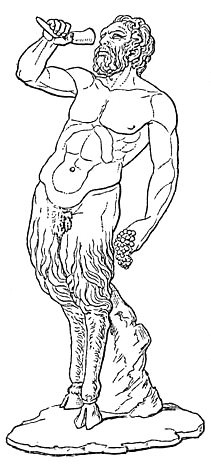Satyrs in Greek mythology are woodland creatures depicted as having the pointed ears, legs, and short horns of a goat and a fondness for unrestrained revelry.
Origins
Satyrs are most commonly described as having the upper half of a man and the lower half of a goat. They are also described as possessing a long thick tail, either that of a goat or a horse. Mature satyrs are often depicted with goat's horns, while juveniles are often shown with bony nubs on their foreheads.
Attic painted vases depict satyrs as being strongly built with flat noses, large pointed ears, long curly hair, and full beards, with wreaths of vine or ivy circling their heads. Satyrs often carry the thyrsus: the rod of Dionysus tipped with a pine cone.
Habitat
Satyrs are mythological nature entities that roamed the woods and mountains, and were the companions of Pan and Dionysus.
Main Belief
Recently works satyrs have become more human, with fewer animal characteristics, until only the tail remains to show that they are satyrs. In most books, drawings, etc., however, they still have their general half-goat, half-man appearance.
They are described as roguish but faint-hearted folk; subversive and dangerous, yet shy and cowardly. As Dionysiac creatures they are lovers of wine, women and boys, and are ready for every physical pleasure. They roam to the music of pipes, cymbals, castanets, and bagpipes]], and love to dance with the nymphs (with whom they are obsessed, and whom they often pursue), and dance to the rhythm of sikinnis. Because of their fondness of wine, they are often represented holding winecups, and appear often in the decorations on winecups.
Satyrs are not immortal, and they age.
Art
Greek mythology and art
In earlier Greek art, satyrs appear as old and ugly, but in later art, especially in works of the Attic school, this savage character is softened into a more youthful and graceful aspect. There is a famous statue said to be a copy of a work of Praxiteles, representing a graceful satyr leaning against a tree with a flute in his hand.
Older satyrs were known as sileni, the younger as satyrisci. The harewas the symbol of the shy and timid satyr. Greek spirits known as Calicantsars have a noticeable resemblance to the ancient satyrs; they have goats' ears and the feet of donkeys or goats, are covered with hair, and love women and the dance.
Although they are not mentioned by Homer, in a fragment of Hesiod's works they are called brothers of the mountain nymphs and Kuretes, strongly connected with the cult of Dionysus, and are an idle and worthless race. In the Dionysus cult, male followers are known as satyrs and female followers as maenads.
In Attica there was a species of drama known as the satyric; it parodied the legends of gods and heroes, and the chorus was composed of satyrs and sileni. In the Athenian satyr plays of the 5th century BCE, the chorus commented on the action. This "satyric drama" burlesqued the serious events of the mythic past with lewd pantomime and subversive mockery. One complete satyr play from the 5th century survives, the Cyclops of Euripides.
A papyrus bearing a long fragment of a satyr play by Sophocles, given the title Tracking Satyrs (Ichneutae), was found at Oxyrhynchus in Egypt, 1907.
Roman mythology and art
Roman satyrs were conflated in the popular and poetic imagination with Latin spirits of woodland and with the rustic spirit Pan, called the Panes.
Roman satyrs were descibed as goatlike from the haunches to the hooves, and were often pictured with larger horns, even ram's horns. Roman poets often confused them with the Fauns.
Roman satire is a literary form, a poetic essay for biting, subversive social and personal criticism. Though Roman satire is sometimes thoughtlessly linked to the Greek satyr plays, satire's only connection to the satyric drama is through the subversive nature of the satyrs themselves, as forces in opposition to urbanity, decorum, and civilization itself.
Other references
In the King James Version of the Bible, Isaiah 13:21 and 34:14, the English word "satyr" is used to represent the Hebrew sh'lrlm, "hairy ones". In Hebrew folklore, sh'lrlm are a type of demon or supernatural being which inhabits waste places. There is an allusion to the practice of sacrificing to the sh'lrlm (often translated as "devils") in Leviticus 17:7.
They correspond to the "shaggy demon of the mountain-pass" of old Arab lore.
Christian mythology demonised all pagan nature spirits such as satyrs by associating them with demons and devils, though they do resemble the Jewish goat-man demon Azazel to whom the scapegoats were sent. The herdsmen of Parnassus also believed in a demon of the mountain who was said to be the lord of hares and goats.
Satyrs in fiction
- Satyrs were some of the enemies that Ares had placed in Pandora's Temple to stop Kratos from getting Pandora's Box in the video game God of War
- In Walt Disney Pictures's 1997 film Hercules, the character Phil is a mix between the Greek hero Philoctetes and the stereotypical satyr; his circumstances are those of the classical Philoctetes, but he looks like a satyr and exhibits satyr-like desires for wine and women.
- Satyricon is the name of a Norwegian Black Metal group. Their frontman and guitarist Sigurd's stage name is Satyr.
Books
- Ely, Talfourd – The Gods of Greece and Rome, Dover. [1]
- Lewis, C.S. The Lion, the Witch, and the Wardrobe, a faun named Mr. Tumnus is the first creature Lucy meets in Narnia [2]
- Seyffert, Oskar; Dictionary of Classical Antiquities, (1894) "Satyric Drama"
- Thurston Peck, Harry Harpers Dictionary of Classical Antiquities.
See also

